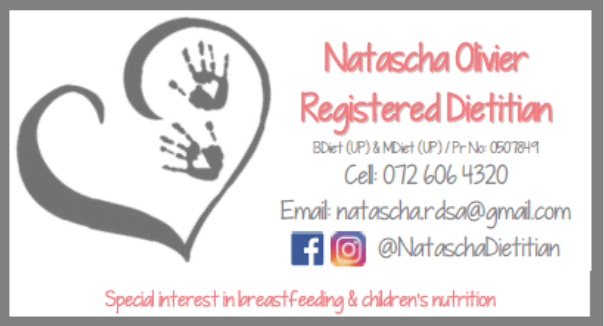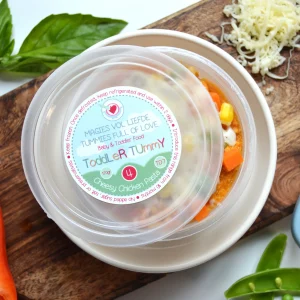Introducing your child to the world of food is an exciting journey for parent and child! It unlocks a whole new world of taste, texture and experimenting!
For parents, it may, however, also unlock a whole new world of questions, concerns, and uncertainties. One of the questions that parents often ask is how many meals a day an infant should have? When do you move from one to two meals, and from two to three meals? When do you offer snacks? Which meals do you introduce first – breakfast, lunch or supper?
The answers to these questions are largely determined by your child! We strongly encourage responsive feeding, which entails observing your baby and responding to their cues. The first, and perhaps most important step of responsive feeding, is to wait until your baby is developmentally ready to start exploring the world of food.
Once your baby meets all of the following developmental milestones, they are ready for food:
- They can sit (mostly) unsupported,
- They have good head and neck control, allowing them to move their head and signal whether they would like another bite or have had enough,
- Their tongue extrusion reflex has mostly disappeared, allowing them to take a spoonful of food into their mouth without their tongue pushing everything off,
- They are willing and able to chew, although they do not require teeth for this, and
- They show interest when you are eating, bringing their hands, etc. to their mouth.
Most healthy and full-term babies meet these milestones at around 6 months, but if you are unsure whether your baby is ready for complementary foods, please contact your dietitian, or other healthcare professional for guidance. If you allow your baby to show you when they are ready for food, the journey will be easier and more fun for both you and your baby.
In addition, if you wait until your baby is developmentally ready for complementary foods, the sequence in which you introduce food groups is irrelevant. This allows you to keep your baby’s food journey exciting, as you can (and should!) introduce them to a wide variety of foods, including meat, chicken, fish and eggs, vegetables, fruit, dairy products, starches, legumes, nuts, etc.
At approximately 6 months of age, your baby’s iron stores are depleted and can no longer meet your baby’s requirements for growth and development. Your baby’s first complementary foods should, therefore, be rich in iron. Iron-rich foods include red meat (esp. liver), dark poultry meat, wholegrain starches, fortified cereals, legumes, egg yolks, and dark green leafy vegetables.
Once your baby is developmentally ready for complementary foods, you can start offering 1-2 teaspoons of a single (preferably iron-rich) food once a day. Watch your baby’s cues and respond appropriately – offer more if they are interested, and stop once they signal that they have had enough.
Offering your baby his/her first meal sometime during the morning allows you to observe for potential intolerances, and to contact healthcare professionals during office hours, should this be necessary. This is, however, not essential, and you can offer your baby their first meal at any time of the day. If your baby enjoys their food (even if it is only a teaspoon or so at a meal), continue offering one meal a day, and observe your baby’s cues. (If your baby does not enjoy the food at all, you may want to wait another week before you try again. If your child is not accepting any food by 7 months of age, contact your dietitian for guidance).
Once your baby has happily been accepting some food (even if it is only a teaspoon or so at a meal) for a week or two, they are ready for a second daily meal. This means that you will now be offering one food or meal during the morning, and another food or meal during the afternoon.
Remember to offer a different food or food group at each meal, including iron-rich foods at least once a day. You do not need to offer single foods only but can combine food groups – mixing meat with vegetables, or fruit with starches, etc. This exposes your baby to a wide variety of foods, even though they might not be eating large amounts per meal.
Once your baby has been enjoying two meals per day for one to two weeks, you can add their third meal, offering food in the morning, at noon, and during the late afternoon or early evening. Continue as above, offering a wide variety of foods, and including iron-rich foods at least once or twice every day.
By 8-9 months of age, you should be offering your baby three meals per day, at least two of which should contain iron-rich foods. Depending on their appetite and interest in food you may want to add a small snack in between meals. By 12 months of age, your baby should be eating 3 meals per day, with 2-3 snacks in between, and should be consuming family foods, although some modifications with regard to size, etc. may still be necessary.
As always, continue observing your baby’s cues, and responding appropriately. This way your child will learn to trust their body’s signals as to when they are hungry or satiated, and how to respond appropriately, resulting in self-regulation, and decreasing their risk of obesity and non-communicable diseases later in life.
Enjoy this exciting food adventure with your baby, and should you have any concerns, please do not hesitate to contact a dietitian for guidance – If it’s about nutrition, ask your dietitian!









